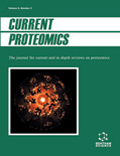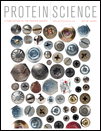
Current Proteomics
Scope & Guideline
Navigating the Evolving Landscape of Proteomics
Introduction
Aims and Scopes
- Proteomic Analysis and Characterization:
The journal emphasizes studies that utilize proteomic techniques to analyze protein expression, modifications, and interactions. This includes quantitative proteomics, mass spectrometry, and protein profiling in various biological contexts. - Computational Proteomics and Bioinformatics:
A significant focus is placed on computational approaches to proteomics, including in silico studies, machine learning applications, and bioinformatics tools that assist in the interpretation of proteomic data and the prediction of protein functions. - Drug Discovery and Therapeutic Applications:
The journal features research that explores the role of proteomics in drug discovery, including the identification of potential biomarkers and therapeutic targets, as well as the evaluation of drug efficacy and mechanisms of action. - Clinical Applications and Disease Mechanisms:
Current Proteomics highlights studies that connect proteomic findings to clinical implications, disease mechanisms, and potential therapeutic strategies, thereby bridging the gap between basic research and clinical practice. - Innovative Methodologies in Proteomics:
The journal encourages submissions that report on novel proteomic techniques, including advancements in mass spectrometry, label-free quantification, and the integration of proteomics with other omics technologies.
Trending and Emerging
- Integration of Omics Technologies:
There is a growing trend towards integrating proteomics with genomics, metabolomics, and transcriptomics. This holistic approach allows for a more comprehensive understanding of biological systems and disease states. - Proteomics in Cancer Research:
The journal shows an increasing focus on the application of proteomics in cancer research, particularly in identifying biomarkers for diagnosis, prognosis, and treatment response, as well as understanding tumor biology. - Immunoinformatics and Vaccine Development:
Emerging studies are focusing on the use of proteomics in immunoinformatics for vaccine development. This includes the design of multi-epitope vaccines and the identification of immunogenic proteins from pathogens. - Personalized Medicine and Precision Proteomics:
There is a noticeable shift towards personalized medicine, with proteomics being leveraged to tailor treatments based on individual protein expression profiles and responses to therapies. - Computational Advancements and Machine Learning:
The application of machine learning and artificial intelligence in analyzing proteomic data is on the rise, offering new tools for data interpretation and predictive modeling within proteomics.
Declining or Waning
- Traditional Proteomic Approaches:
There seems to be a waning interest in traditional proteomic methodologies, such as two-dimensional gel electrophoresis, as researchers increasingly favor more advanced techniques like mass spectrometry-based approaches that offer higher resolution and sensitivity. - Basic Studies without Clinical Relevance:
Research focusing solely on basic proteomic studies without clear clinical applications or implications is becoming less common. The journal appears to prioritize studies that connect proteomic data to disease mechanisms or therapeutic implications. - Limited Scope of Plant Proteomics:
Although plant proteomics has been a significant area of research, recent publications suggest a decline in studies focused exclusively on plant proteins, possibly due to a broader focus on human health and disease-related proteomics.
Similar Journals

PROTEIN SCIENCE
Driving Innovation in Molecular Biology and MedicinePROTEIN SCIENCE, published by Wiley, is a premier journal dedicated to the field of biochemistry, molecular biology, and medicine, boasting an impressive impact factor that reflects its influence and importance within the academic community. Established in 1992, the journal has continuously provided a platform for high-quality research, with a current classification in the top quartile (Q1) for its critical contributions to the understanding of protein structure and function, as well as its applications in health and disease. With a Scopus ranking placing it in the 91st percentile among its peers, PROTEIN SCIENCE publishes cutting-edge studies and reviews that are essential for researchers, professionals, and students seeking to advance their knowledge in protein research. Although it does not currently offer open access options, the journal remains dedicated to disseminating vital findings that support the ongoing advancements in molecular biology and biochemistry. Researchers can count on PROTEIN SCIENCE for consistently rigorous peer-reviewed content that fosters meaningful dialog and innovation in the life sciences.

Expert Review of Proteomics
Pioneering Reviews in the World of Proteomics.Expert Review of Proteomics, published by TAYLOR & FRANCIS LTD, is a distinguished journal that focuses on the latest advancements in the field of proteomics, a critical area within biochemistry and molecular biology. With an ISSN of 1478-9450 and E-ISSN 1744-8387, this journal has been pivotal in disseminating high-quality research from its inception in 2004 to its planned convergence in 2024. Its influential position is reflected in its 2023 rankings, placing it in the Q2 category for both Biochemistry and Molecular Biology, alongside respectable Scopus rankings that rank it 118th and 141st in its respective categories. Despite its non-open access structure, Expert Review of Proteomics provides researchers and professionals with a vital platform for critical reviews and insights into proteomic methodologies, thus contributing significantly to the global scientific community. By bridging theoretical research with practical applications, it serves as an essential resource for those dedicated to advancing their knowledge and expertise in this dynamic field.

PROTEIN JOURNAL
Transforming Insights into Biomedical ApplicationsProtein Journal, published by Springer, stands as a significant academic resource in the fields of Analytical Chemistry, Biochemistry, Bioengineering, and Organic Chemistry. Since its inception in 1996, the journal has dedicated itself to the dissemination of high-quality research focused on protein chemistry and its biomedical applications. With an impressive impact reflected in its classification as a Q2 journal in Analytical Chemistry and Q3 in both Biochemistry and Bioengineering as of 2023, it provides an essential platform for researchers and practitioners to share their findings. The journal embraces the open-access model, enhancing accessibility to cutting-edge research. The Protein Journal is crucial for academicians, industry professionals, and students, catering to their need for rigorous scientific discourse and innovative discoveries in protein studies. With an established track record of converging over two decades of knowledge and research, it continues to influence and shape the advancements in this vital area of science.

Proteomics Clinical Applications
Advancing Clinical Insights Through ProteomicsProteomics Clinical Applications, published by Wiley-VCH Verlag GmbH, is a pivotal journal in the realm of Clinical Biochemistry, with an impressive track record since its inception in 2007, continuing its impactful contributions to 2024. With an ISSN of 1862-8346 and an E-ISSN of 1862-8354, this prestigious journal currently holds a commendable Q2 ranking in Clinical Biochemistry, situated at the 54th percentile among its peers within Scopus rankings. Dedicated to the advancement of proteomics and its applications in clinical settings, Proteomics Clinical Applications serves as a bastion for innovative research, fostering knowledge exchange among scientists, healthcare professionals, and students alike. Through its focus on novel methodologies and translational research, the journal aims to bridge the gap between laboratory findings and clinical practice, significantly impacting patient care and outcomes. Although not open access, its content is accessible through various academic databases, ensuring that vital research reaches its intended audience.

BIOLOGICAL PROCEDURES ONLINE
Catalyzing Discoveries in Biochemistry and Molecular Science.BIOLOGICAL PROCEDURES ONLINE is a premier open-access journal published by BMC, dedicated to advancing the fields of biochemistry, genetics, and molecular biology. With its electronic ISSN 1480-9222 and a strong commitment to accessibility since 2009, this journal provides a vital platform for researchers and scholars to disseminate their findings and foster collaboration within the scientific community. Based in the United Kingdom, this journal has garnered an impressive reputation, achieving Q1 status in the 2023 category rankings, with notable inclusion in the Scopus rankings, placing it in the 86th percentile among 221 peer journals in the general biochemistry, genetics, and molecular biology domain. It covers a broad range of topics, ensuring coverage of the latest advancements and methodologies in biological procedures, making it an essential resource for academics, practitioners, and students alike. Researchers are encouraged to submit their innovative work and contribute to the ongoing dialogue in this dynamic and ever-evolving field.

COMPUTATIONAL BIOLOGY AND CHEMISTRY
Unraveling Complex Biological Mysteries with Computational PrecisionCOMPUTATIONAL BIOLOGY AND CHEMISTRY is a distinguished academic journal published by Elsevier Science Ltd, focusing on the dynamic intersection of computational biology, biochemistry, and chemistry. With an ISSN of 1476-9271 and an E-ISSN of 1476-928X, this journal is committed to disseminating high-quality research that employs computational techniques to solve complex biological and chemical problems. As of 2023, the journal holds a substantial impact factor reflecting its significance and rigorous peer-review process, categorized in the Q2 quartile for both Computational Mathematics and Organic Chemistry, alongside Q3 classifications in Biochemistry and Structural Biology. With a continuous publication history spanning from 2003 to 2024, it serves as a critical resource for researchers, professionals, and students alike. The journal offers various open access options, ensuring that vital research findings are accessible to a global audience, further enhancing collaboration across disciplines. Engage with cutting-edge studies and contribute to the evolving landscape of computational methodologies in the life sciences through this esteemed publication.

MedComm is a distinguished Open Access journal published by Wiley, located in the United States. Since its inception in 2020, it has rapidly established itself as a leading platform for cutting-edge research in the fields of Biochemistry, Cell Biology, Drug Discovery, Genetics, Immunology and Allergy, and Oncology, achieving a prestigious Q1 category ranking across multiple disciplines in 2023. MedComm is committed to providing a rigorous and transparent peer-review process, ensuring the publication of high-quality articles that advance the frontiers of medical science. With its remarkable Scopus ranking, the journal serves as an invaluable resource for researchers, professionals, and students looking to stay abreast of important developments in the life sciences. The open access model facilitates widespread dissemination of scholarly work, fostering collaboration and innovation within the global scientific community. Researchers interested in submitting their work or exploring the latest findings are encouraged to engage with this pivotal journal during the converged years from 2020 to 2024.

Proteomes
Championing Open Access to Cutting-Edge Proteomic Research.Proteomes, published by MDPI since 2013, is a notable open access journal that occupies a critical place in the realms of Biochemistry, Clinical Biochemistry, Molecular Biology, and Structural Biology. Based in Switzerland, this journal not only promotes the dissemination of high-quality research pertaining to protein structures and functions but also emphasizes interdisciplinary approaches that bridge various fields of biomedical science. With a Category Quartile ranking of Q2 across multiple pertinent categories in 2023, Proteomes boasts a competitive impact within the scientific community, evidenced by its robust Scopus rankings. Researchers, professionals, and students are invited to explore a wealth of pioneering studies and reviews that are made freely accessible, aligning with global trends in open scientific communication. Whether contributing original research or seeking to expand their knowledge, the journal serves as an invaluable resource for anyone engaged in the evolving landscape of proteomics.

Current Bioinformatics
Pioneering Research in Bioinformatics and BeyondCurrent Bioinformatics, an esteemed journal published by Bentham Science Publishers Ltd, serves as a pivotal platform for the dissemination of cutting-edge research in the fields of bioinformatics, biochemistry, computational mathematics, genetics, and molecular biology. With an ISSN of 1574-8936 and an E-ISSN of 2212-392X, this journal has established itself as a vital resource for researchers, professionals, and students keen on exploring interdisciplinary approaches to biological data analysis. Its prominence is reflected in its quartile rankings for 2023, where it stands in Q3 for biochemistry and computational mathematics, alongside Q4 rankings in genetics and molecular biology. Current Bioinformatics, located in the United Arab Emirates and converging from 2007 to 2024, aims to foster innovation in the field by presenting original research articles, reviews, and case studies that drive forward our understanding of complex biological systems through computational techniques. This journal is an integral resource for those wishing to stay at the forefront of bioinformatics research and applications.

Frontiers in Molecular Biosciences
Catalyzing Innovation in Molecular BiosciencesFrontiers in Molecular Biosciences is an esteemed open-access journal published by FRONTIERS MEDIA SA, based in Switzerland. Since its inception in 2014, the journal has made significant strides in the fields of biochemistry, genetics, and molecular biology, cementing its reputation with a solid position in the Q1 quartile for both Biochemistry and Genetics and Molecular Biology (miscellaneous) categories as of 2023. With a remarkable Scopus rank of #14/103 in the combined categories, it offers an essential platform for the dissemination of high-quality research that shapes the understanding of molecular processes and their implications in health and disease. The journal’s commitment to open access facilitates the broadest possible reach for groundbreaking discoveries, serving as a vital resource for researchers, professionals, and students alike. Located at AVENUE DU TRIBUNAL FEDERAL 34, LAUSANNE, this journal continues to foster innovative discussions and advancements in molecular biosciences, paving the way for new insights and collaborations in the scientific community.